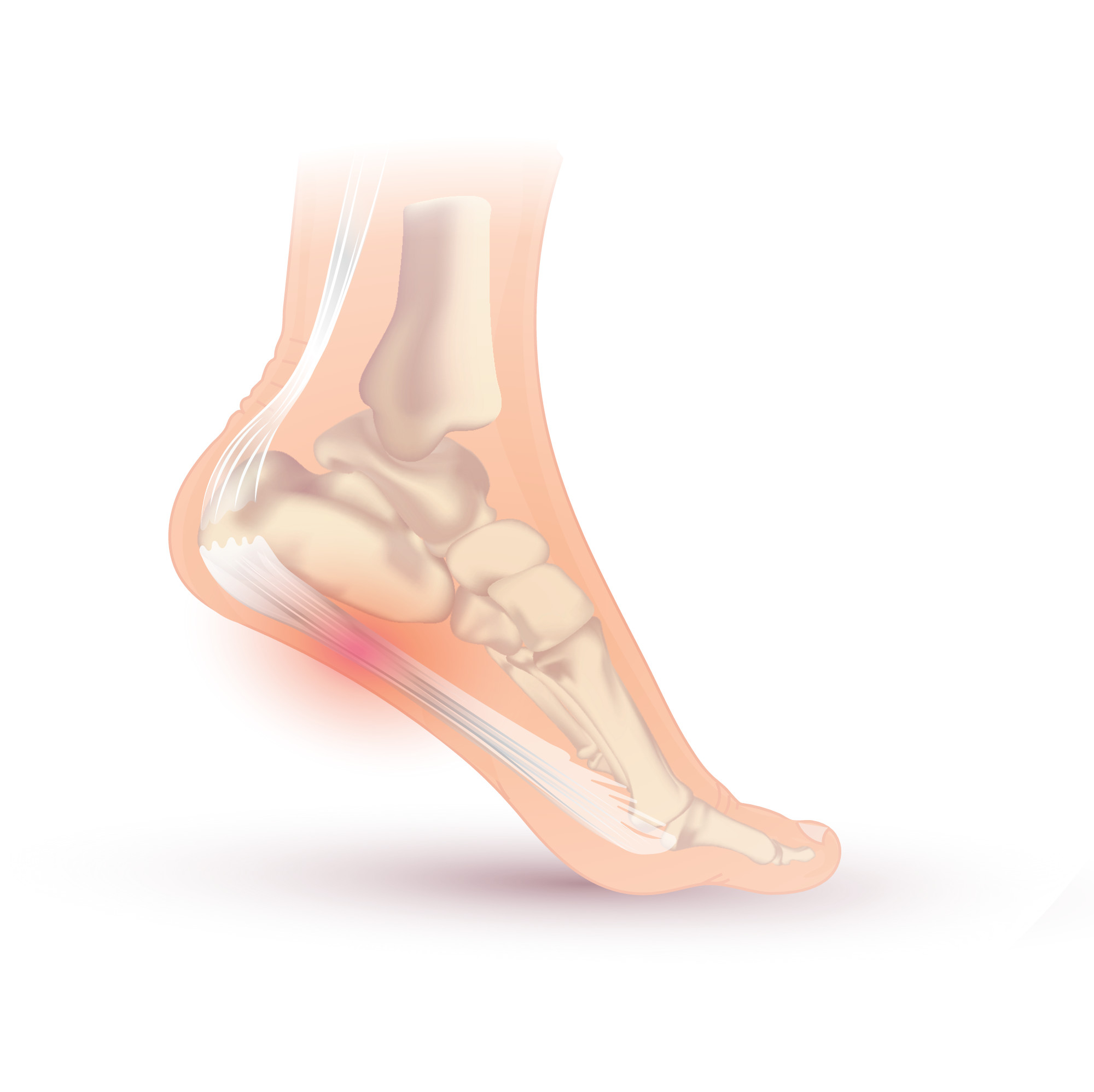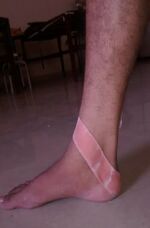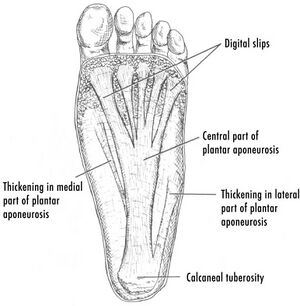Plantar Fasciitis: Difference between revisions
No edit summary |
|||
| (4 intermediate revisions by the same user not shown) | |||
| Line 2: | Line 2: | ||
{{Condition | {{Condition | ||
|quality=Partial | |quality=Partial | ||
|image=Plantar fasciitis.jpg | |||
}} | }} | ||
'''Plantar fasciitis''' is the most common cause of chronic heel pain, with a lifetime prevalence of up to 10%. | '''Plantar fasciitis''' is the most common cause of chronic heel pain, with a lifetime prevalence of up to 10%. | ||
== Anatomy == | == Anatomy == | ||
The deep plantar fascia, also known as the plantar aponeurosis, is a thick, pearly-white fibrous tissue with longitudinally oriented fibres that are intimately attached to the skin. The thickest area is found centrally where it attaches to the medial process of the tuberosity of the calcaneal. Distally it divides into separate slips for each of the five toes. | {{See also|Foot and Ankle Biomechanics}} | ||
[[File:Plantar fascia.jpg|thumb|Plantar fascia]]The deep plantar fascia, also known as the plantar aponeurosis, is a thick, pearly-white fibrous tissue with longitudinally oriented fibres that are intimately attached to the skin. The thickest area is found centrally where it attaches to the medial process of the tuberosity of the calcaneal. Distally it divides into separate slips for each of the five toes. | |||
== Aetiology == | == Aetiology == | ||
| Line 16: | Line 18: | ||
== Epidemiology == | == Epidemiology == | ||
Peak incidence is between 40-60 years. There is a younger peak in runners. It is bilateral in up to one third of cases. | Peak incidence is between 40-60 years. There is a younger peak in runners. It is bilateral in up to one third of cases. | ||
Decreased ankle dorsiflexion(running on your forefoot technique) and high body mass index are risk factors for development of plantar fasciitis. (See [[Foot and Ankle Biomechanics]]) | |||
==Clinical Features== | ==Clinical Features== | ||
| Line 28: | Line 32: | ||
{{DDX Box|ddx-title=Differential Diagnosis of Heel Pain|ddx-text={{Heel Pain DDX}}}} | {{DDX Box|ddx-title=Differential Diagnosis of Heel Pain|ddx-text={{Heel Pain DDX}}}} | ||
==Treatment== | ==Treatment== | ||
[[File:Calcaneal taping.jpg|thumb|228x228px|Calcaneal taping.<ref name=":0" />]] | |||
===First line=== | ===First line=== | ||
| Line 33: | Line 38: | ||
'''Shoe inserts:''' Felt pads or rubber heel cups seem to be less effective than silicone inserts. | '''Shoe inserts:''' Felt pads or rubber heel cups seem to be less effective than silicone inserts. | ||
'''Mulligan calcaneal taping:''' The patient is seated on the bed with the foot hanging down and the hip is in abduction and external rotation. The ankle is relaxed. Two layers are applied, an under-wrap and a brown rigid over-wrap. Apply the tape diagonally on the lateral surface of the calcaneum. Hold the calcaneum in external rotation and adduction. Pull the tape around the ankle medially and around superior to the Achilles tendon while sustaining the glide.<ref name=":0">{{Cite journal|last=Agrawal|first=Sonal Subhash|date=|title=Effectiveness of Mulligan’s taping for the short term management of plantar heel pain – Randomised control trial|url=http://ssjournals.com/index.php/ijbar|journal=International Journal of Biomedical and Advance Research|volume=|pages=|doi=10.7439/ijbar|pmid=|via=|doi-access=}}[https://www.ssjournals.com/index.php/ijbar/article/view/2303 Full Text]</ref> | |||
===Second line=== | ===Second line=== | ||
| Line 38: | Line 45: | ||
'''Dextrose [[Prolotherapy Injection|prolotherapy]]''': In a systematic review of 8 studies (2 RCTs, 444 patients total), dextrose prolotherapy was found to be more effective than exercise and normal saline injection, however better quality studies are needed. In the 2 RCTs dextrose prolotherapy showed no significant difference to other treatments after 6 months. The concentrations used were 13.5-20% but one study used 1.5%. Generally 2-3 injections were given in intervals of 1-3 weeks.<ref>{{Cite journal|last=Chutumstid|first=Tunchanok|last2=Susantitapong|first2=Paweena|last3=Koonalinthip|first3=Nantawan|date=2022-03-25|title=Effectiveness of Dextrose prolotherapy for the treatment of chronic Plantar Fasciitis: A Systematic Review and Meta-Analysis of Randomized Controlled Trials|url=https://pubmed.ncbi.nlm.nih.gov/35338597|journal=PM & R: the journal of injury, function, and rehabilitation|doi=10.1002/pmrj.12807|issn=1934-1563|pmid=35338597}}</ref> | '''Dextrose [[Prolotherapy Injection|prolotherapy]]''': In a systematic review of 8 studies (2 RCTs, 444 patients total), dextrose prolotherapy was found to be more effective than exercise and normal saline injection, however better quality studies are needed. In the 2 RCTs dextrose prolotherapy showed no significant difference to other treatments after 6 months. The concentrations used were 13.5-20% but one study used 1.5%. Generally 2-3 injections were given in intervals of 1-3 weeks.<ref>{{Cite journal|last=Chutumstid|first=Tunchanok|last2=Susantitapong|first2=Paweena|last3=Koonalinthip|first3=Nantawan|date=2022-03-25|title=Effectiveness of Dextrose prolotherapy for the treatment of chronic Plantar Fasciitis: A Systematic Review and Meta-Analysis of Randomized Controlled Trials|url=https://pubmed.ncbi.nlm.nih.gov/35338597|journal=PM & R: the journal of injury, function, and rehabilitation|doi=10.1002/pmrj.12807|issn=1934-1563|pmid=35338597}}</ref> | ||
==Resources== | |||
{{PDF|Evaluation and Treatment of Chronic Plantar Fasciitis - Latt 2020.pdf|Evaluation and Treatment of Chronic Plantar Fasciitis - Latt 2020}} | |||
==References== | ==References== | ||
[[Category:Foot and Ankle Conditions]] | [[Category:Foot and Ankle Conditions]] | ||
{{References}} | {{References}} | ||
{{Reliable sources}} | {{Reliable sources}} | ||
Latest revision as of 07:20, 8 May 2022

| |
| Plantar Fasciitis |
|---|
Plantar fasciitis is the most common cause of chronic heel pain, with a lifetime prevalence of up to 10%.
Anatomy
- See also: Foot and Ankle Biomechanics
The deep plantar fascia, also known as the plantar aponeurosis, is a thick, pearly-white fibrous tissue with longitudinally oriented fibres that are intimately attached to the skin. The thickest area is found centrally where it attaches to the medial process of the tuberosity of the calcaneal. Distally it divides into separate slips for each of the five toes.
Aetiology
Risk factors are obesity, prolonged standing or jumping, flat feet, reduced ankle dorsiflexion. It can occur in isolation or in conjunction with spondyloarthritis.
Pathophysiology
Unknown, but thought to be a degenerative fasciopathy/enthesopathy.
Epidemiology
Peak incidence is between 40-60 years. There is a younger peak in runners. It is bilateral in up to one third of cases.
Decreased ankle dorsiflexion(running on your forefoot technique) and high body mass index are risk factors for development of plantar fasciitis. (See Foot and Ankle Biomechanics)
Clinical Features
Medial heel pain that is worse in the first few steps in the morning.
Dorsiflex the patients toes to pull the plantar fascia taut, then palpate for tenderness.
Investigations
Ultrasound may show thickened plantar fascia >4mm.
Differential Diagnosis
- Plantar Fasciitis
- Fat Pad Contusion
- Calcaneal fractures (traumatic and stress)
- Inferior Calcaneal (Baxter) Nerve Entrapment
- Medial Calcaneal Nerve Entrapment
- Lateral Plantar Nerve Entrapment
- Medial Plantar Nerve Entrapment
- Tarsal Tunnel Syndrome
- Lumbar Radicular Pain
- Talar stress fracture
- Retrocalcaneal bursitis
- Spondyloarthritis
- Osteoid osteoma
- CRPS
Treatment

First line
Common treatments are manual therapy, exercise, stretching, heel pads, taping, orthotics, night splints, education, activity modification, NSAIDs, and weight loss.
Shoe inserts: Felt pads or rubber heel cups seem to be less effective than silicone inserts.
Mulligan calcaneal taping: The patient is seated on the bed with the foot hanging down and the hip is in abduction and external rotation. The ankle is relaxed. Two layers are applied, an under-wrap and a brown rigid over-wrap. Apply the tape diagonally on the lateral surface of the calcaneum. Hold the calcaneum in external rotation and adduction. Pull the tape around the ankle medially and around superior to the Achilles tendon while sustaining the glide.[1]
Second line
Second line treatments include extracorporeal shockwave therapy (ESWT), corticosteroid injection, PRP injection, dextrose prolotherapy, and fasciotomy.
Dextrose prolotherapy: In a systematic review of 8 studies (2 RCTs, 444 patients total), dextrose prolotherapy was found to be more effective than exercise and normal saline injection, however better quality studies are needed. In the 2 RCTs dextrose prolotherapy showed no significant difference to other treatments after 6 months. The concentrations used were 13.5-20% but one study used 1.5%. Generally 2-3 injections were given in intervals of 1-3 weeks.[2]
Resources
References
- ↑ 1.0 1.1 Agrawal, Sonal Subhash. "Effectiveness of Mulligan's taping for the short term management of plantar heel pain – Randomised control trial". International Journal of Biomedical and Advance Research. doi:10.7439/ijbar.Full Text
- ↑ Chutumstid, Tunchanok; Susantitapong, Paweena; Koonalinthip, Nantawan (2022-03-25). "Effectiveness of Dextrose prolotherapy for the treatment of chronic Plantar Fasciitis: A Systematic Review and Meta-Analysis of Randomized Controlled Trials". PM & R: the journal of injury, function, and rehabilitation. doi:10.1002/pmrj.12807. ISSN 1934-1563. PMID 35338597.
Literature Review
- Reviews from the last 7 years: review articles, free review articles, systematic reviews, meta-analyses, NCBI Bookshelf
- Articles from all years: PubMed search, Google Scholar search.
- TRIP Database: clinical publications about evidence-based medicine.
- Other Wikis: Radiopaedia, Wikipedia Search, Wikipedia I Feel Lucky, Orthobullets,



